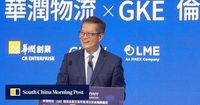China’s influence over the global metals market has rarely been more evident than in the summer of 2025, as the country’s rare-earth exports surged and Hong Kong cemented its role as a critical hub for the world’s metals trade. Recent customs data and official statements from both mainland and Hong Kong authorities underscore a dynamic, rapidly evolving landscape—one shaped by geopolitics, technological innovation, and the relentless march of green industries.
According to Eurasia Business News, China’s rare-earth product exports rebounded sharply in July 2025, reaching their highest level since the start of the year. The country exported 7,742 metric tonnes of rare earths in July—a 32% increase from May and a staggering 60% jump compared to June 2024. This uptick followed a temporary dip in June, but the overall trend remains upward: the total export volume for the first seven months of 2025 hit 38,563.6 tons, marking a 13% increase compared to the same period last year.
This rebound wasn’t just a matter of market demand. As Eurasia Business News reports, it reflected China’s decision to ease some of the export restrictions and licensing delays that had been imposed earlier in 2025. These controls were initially introduced as a countermeasure to U.S. tariffs and mounting geopolitical tensions. The result? A global sigh of relief from industries dependent on these critical minerals, which are essential for everything from smartphones to wind turbines.
But the story doesn’t end with rare earths alone. In June, China’s rare earth magnet exports to the United States surged by an eye-popping 660% compared to May, reaching 353 metric tons. This leap followed a significant Sino-U.S. trade agreement that resolved previous restrictions and disputes affecting the shipment of rare earth minerals and magnets. The agreement provided a much-needed reprieve for U.S. manufacturers, who had been grappling with supply shortages and price spikes.
Despite these recent export surges, China continues to exercise tight control over its rare-earth sector. The country dominates about 90% of the world’s rare-earth magnet production and has been steadily tightening oversight on certain strategic rare earths, particularly those used in military and high-tech sectors. As Eurasia Business News points out, this strategic management allows China to maintain leverage amid ongoing efforts by Western nations to diversify their supply chains and reduce dependence on Chinese exports.
Meanwhile, just across the border, Hong Kong is seizing its own moment in the metals spotlight. On August 19, 2025, the city launched two of eight warehouse facilities certified by the London Metal Exchange (LME), extending the LME’s global network right to the doorstep of mainland China. The move is being hailed as a milestone for both Hong Kong’s economy and China’s broader development ambitions.
At the launch ceremony, Hong Kong Financial Secretary Paul Chan described the development as “of great significance for supporting [China’s] development strategy” and “enhancing Hong Kong’s status as an international financial and shipping centre,” according to South China Morning Post. Chan emphasized that establishing a delivery point so close to the mainland—one of the world’s largest markets for metal consumption and export—will “undoubtedly greatly reduce logistics time and costs compared with relying on overseas warehouses, thereby improving allocation efficiency.”
Why is this so important? For starters, China is the world’s largest non-ferrous metals producer and the top consumer of six major non-ferrous metals: copper, aluminium, zinc, lead, nickel, and tin. In 2024 alone, mainland China’s trade in non-ferrous metals reached an eye-watering US$368.79 billion, an 11.4% increase from the previous year. With such massive volumes in play, even small improvements in logistics and storage can translate into significant cost savings and efficiency gains across global supply chains.
The timing of Hong Kong’s new LME-certified warehouses couldn’t be better. The rising demand for metals is being driven by the explosive growth of green technologies. Electric vehicles and solar panels, for example, require substantial amounts of copper, lithium, nickel, and cobalt—all of which are actively traded on the LME. As the world races to decarbonize, these metals have become the backbone of the energy transition.
But there’s another layer to the story: technology. In 2025, China has witnessed a rapid expansion of artificial intelligence data centres, following the emergence of DeepSeek earlier this year. This new frontier is fueling demand for copper even further, as data centres require vast amounts of the metal for wiring and cooling systems. As South China Morning Post highlights, this tech-driven appetite is adding to the already robust demand from green industries.
For Hong Kong, the benefits of joining the LME’s warehouse network extend far beyond logistics. The city has long positioned itself as a bridge between East and West—a role that is only becoming more vital as geopolitical tensions simmer and global supply chains fragment. By hosting LME-certified warehouses, Hong Kong is not only enhancing its own status as a financial and shipping centre, but also reinforcing its strategic importance to both China and the wider world.
Of course, none of this happens in a vacuum. The interplay between China’s export policies, U.S. trade relations, and the broader push for supply chain diversification continues to shape the global metals market. While the recent easing of export restrictions has brought some stability, the underlying dynamics remain complex and, at times, unpredictable.
Western nations, for their part, are still actively seeking ways to reduce their reliance on Chinese rare earths and other critical minerals. Initiatives to develop alternative suppliers in Africa, Australia, and North America are underway, but progress has been slow. For now, China’s dominance—especially in rare-earth magnet production—remains unchallenged.
As the world’s appetite for metals grows—driven by everything from electric cars to artificial intelligence—the stakes have never been higher. China’s ability to manage its vast resources strategically, while leveraging Hong Kong’s unique position in the global trading ecosystem, gives it a formidable edge. But with that power comes responsibility, and the world will be watching closely to see how China balances its national interests with the needs of an interconnected global economy.
In the months ahead, all eyes will be on the flow of rare earths, the performance of Hong Kong’s new LME warehouses, and the evolving dance between East and West. For now, one thing is clear: the metals market is more interconnected—and more strategically charged—than ever before.




